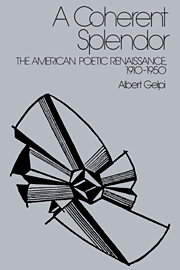Book contents
- Frontmatter
- Contents
- Acknowledgments
- Dedication
- Introduction. The Janus-Face of Romanticism and Modernism
- 1 Robert Frost and John Crowe Ransom: Diptych of Ironists, the Woodsman and the Chevalier
- 2 Wallace Stevens: World as Mundo, Mundo as World
- 3 T. S. Eliot: The Lady Between the Yew Trees
- 4 Ezra Pound: Between Kung and Elcusis
- 5 H. D.: Helen in Bethlehem, Hilda in Egypt
- 6 William Carlos Williams: Mother-Son and Paterson
- 7 Allen Tate and Hart Crane: Diptych with Angels and Demons
- Coda. Yvor Winters and Robinson Jeffers: The Janus-Face of Anti-Modernism
- Notes
- Index
2 - Wallace Stevens: World as Mundo, Mundo as World
Published online by Cambridge University Press: 22 January 2010
- Frontmatter
- Contents
- Acknowledgments
- Dedication
- Introduction. The Janus-Face of Romanticism and Modernism
- 1 Robert Frost and John Crowe Ransom: Diptych of Ironists, the Woodsman and the Chevalier
- 2 Wallace Stevens: World as Mundo, Mundo as World
- 3 T. S. Eliot: The Lady Between the Yew Trees
- 4 Ezra Pound: Between Kung and Elcusis
- 5 H. D.: Helen in Bethlehem, Hilda in Egypt
- 6 William Carlos Williams: Mother-Son and Paterson
- 7 Allen Tate and Hart Crane: Diptych with Angels and Demons
- Coda. Yvor Winters and Robinson Jeffers: The Janus-Face of Anti-Modernism
- Notes
- Index
Summary
Robert Frost liked to tell an anecdote about Wallace Stevens and himself. According to the story, Stevens once remarked to him that the trouble with Frost's poetry was that it was about subjects, in reply to which Frost wisecracked that the trouble with Stevens' poetry was that it was about bric-a-brac. Stevens is made to question Frost's tenacious involvement with external circumstance, which leads him to postulate, at least for the sake of argument, certain scientific, social, and metaphysical hypotheses; Frost's rejoinder is that Stevens' retreat into verbal artifice makes his verse, however glittering and tinselly, detached from reality and so useless except for decorative purposes. Frost's story represents more than a cheap potshot at a fellow poet because it springs from the ingrained Puritan suspicion of art as a lie – and a lie, to boot, which works on and from the bodily senses. Emerson offered a Romantic solution to the problem when he turned the preacher into a poet by making the poet a prophet who sees and says the truth. Frost's modern pragmatism keeps him from following his Emersonian inclinations, and in contrasting his truth telling, albeit skeptical truth telling, with Stevens' fake images, Frost was invoking the old dichotomy to justify his kind of poetry and dismiss Stevens' as frippery.
Needless to say, the complexity of both poets is belied by the joke, though Frost – since it is his joke – comes off better. Still, in its erroneously simpleminded way, it provides a point of departure for two poets who came from different places but from the same time.
- Type
- Chapter
- Information
- A Coherent SplendorThe American Poetic Renaissance, 1910–1950, pp. 49 - 90Publisher: Cambridge University PressPrint publication year: 1988



